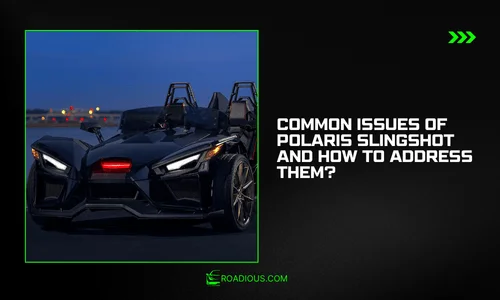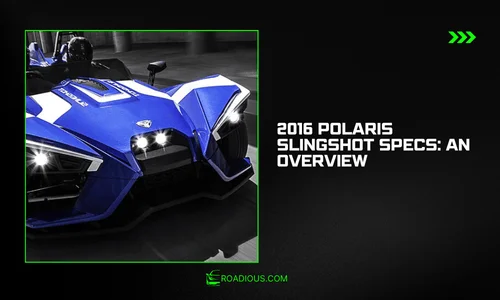The 2016 Polaris Slingshot is a thrill to drive, no doubt about it. But owning one also means staying on top of a few recurring problems. I’ve worked with several Slingshot owners who’ve faced everything from electrical quirks to transmission headaches. Thankfully, most of these issues are manageable when you know what to look out for. Here, I’ll break down the most frequent issues reported by 2016 Polaris Slingshot owners and share solutions that have proven effective based on real-world experience.

Common Mechanical and Performance Issues
Engine Performance Problems
Rough idling, random stalling, and overheating are issues I’ve seen crop up often. These usually point back to clogged fuel injectors, faulty temperature sensors, or low coolant. I recommend frequent engine checks, especially oil and coolant levels, and a good injector cleaner every few thousand miles to keep the system running smoothly.
Transmission and Clutch Concerns
Difficulty shifting gears or a slipping clutch can turn a fun ride into a frustrating one. More often than not, it’s due to worn clutch plates or low transmission fluid. Topping up fluids regularly and inspecting the clutch for wear can save you from bigger repairs. Early action makes all the difference here.
Read More: 2016 Polaris Slingshot Specs
Suspension and Ride Comfort
A stiff, uncomfortable ride can take away from the Slingshot’s appeal. This usually comes down to stock suspension settings not suiting every driver. Personally, I’ve helped a few owners upgrade to aftermarket shocks or fine-tune factory settings, and it’s transformed their experience. Regular inspections of suspension parts also help catch wear early.
Electrical System Challenges
Battery and Charging Problems
Battery drain is a common complaint. Parasitic draws or a weak alternator are usually behind it. I always advise checking for any aftermarket additions that could be pulling power and testing the alternator output regularly. A battery tender can also be a lifesaver if you leave the vehicle parked for long periods.
As Jason Rawlings, a certified powersports technician, explains,
“The Slingshot’s charging system is sensitive to aftermarket electronics. Even a small stereo upgrade can introduce parasitic drain if not wired properly.”
Faulty Wiring and Electrical Glitches
Intermittent power loss, flickering lights, or malfunctioning displays can all trace back to loose wiring or frayed cables. A thorough visual check of the wiring harness often reveals these small faults. Addressing them quickly can prevent larger system failures.
Safety and Structural Concerns
Brake System Issues
Squeaky brakes or a soft pedal are red flags. Often, it’s worn pads or old fluid. I suggest checking pads every few thousand miles and flushing brake fluid at regular intervals. Staying ahead of this helps ensure strong, reliable stopping power. According to Brianna Cole, senior engineer at MotoSafe Testing Labs,
“Brake wear in open-cockpit vehicles like the Slingshot tends to accelerate due to greater exposure to debris and moisture. Regular pad inspections are critical.”
Stability and Traction Control Malfunctions
Sensor errors can mess with your stability control, triggering warning lights or odd handling. A diagnostic scan tool can quickly pinpoint whether it’s a sensor or a software fault. Don’t ignore the lights, get them checked before things worsen.
Recalls and Manufacturer Solutions
Notable Recalls for the 2016 Slingshot
Polaris has issued recalls for the 2016 model, including brake failure risks and swing arm issues. If you haven’t already, visit your dealer to verify if your VIN is affected. These repairs are free and can prevent serious issues.
Polaris’s Response to Reported Problems
I give Polaris credit; they’ve handled reported problems with transparency. Their dealer network often resolves recall items promptly, and they offer support for warranty-covered issues. Regular contact with your local dealer helps you stay in the loop.
Preventive Maintenance Tips
Regular Maintenance Checklist
A routine checklist should include oil changes, brake inspections, and tire checks. I advise keeping a maintenance log, it keeps you accountable and can help with resale value later. Preventive care is the best way to avoid breakdowns.
Proper Storage and Seasonal Care
When storing for the winter, fill up the fuel tank, disconnect the battery, and keep it covered. Moisture and cold can cause damage over time. A garage or covered area with steady temperatures is best. These small steps preserve performance year-round.
Final Takeaways
The 2016 Polaris Slingshot is undeniably fun, but being aware of its common issues is just smart ownership. From engine hiccups to electrical annoyances, most problems have straightforward fixes. Stay proactive with maintenance and recall checks, and you’ll get the most out of your Slingshot on every ride.





